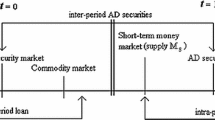Summary.
In this article we study the effects of transaction costs on asset prices. We assume an overlapping generations economy with two riskless assets. The first asset is liquid while the second asset carries proportional transaction costs. We show that agents buy the liquid asset for short-term investment and the illiquid asset for long-term investment. When transaction costs increase, the price of the liquid asset increases. The price of the illiquid asset decreases if the asset is in small supply, but may increase if the supply is large. These results have implications for the effects of transaction taxes and commission deregulation.
Similar content being viewed by others
Author information
Authors and Affiliations
Additional information
Received: December 5, 1997; revised version: March 19, 1998
Rights and permissions
About this article
Cite this article
Vayanos, D., Vila, JL. Equilibrium interest rate and liquidity premium with transaction costs. Economic Theory 13, 509–539 (1999). https://doi.org/10.1007/s001990050268
Issue Date:
DOI: https://doi.org/10.1007/s001990050268




